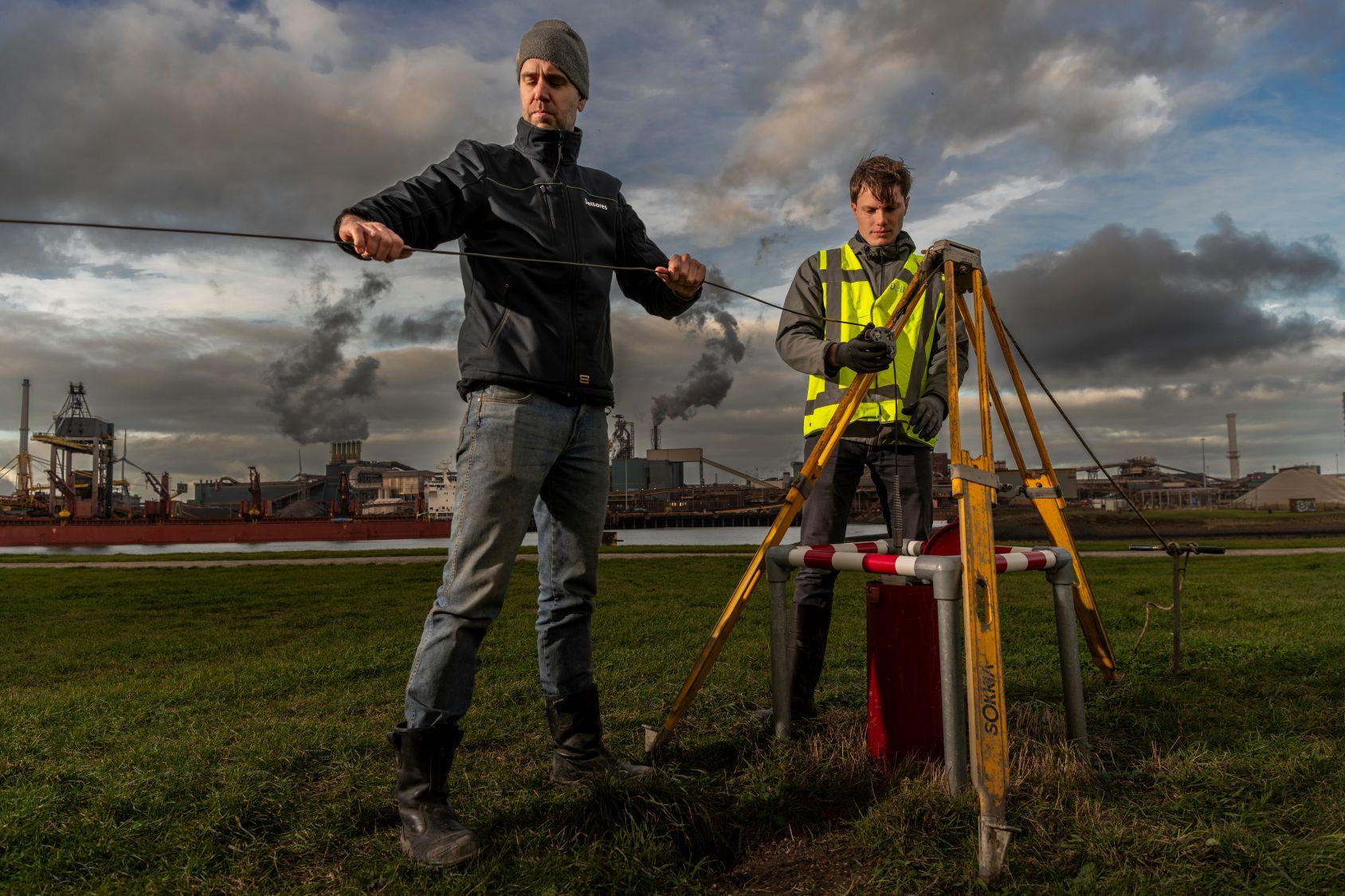Documenting groundwater dynamics
The construction of the IJmuiden Sea Lock has significantly deepened the bed of the North Sea Canal there. How has the deepened canal bed affected the fresh groundwater below it? Has the new situation increased the risk of the groundwater around the lock complex becoming saline? Deltares is conducting research on behalf of Rijkswaterstaat. ‘Groundwater changes very slowly, which is why you have to take measurements over a long period of time to be able to detect changes,’ says researcher Pieter Pauw.

In a strong north wind, Pieter Pauw and Roel Melman are making preparations for a groundwater measurement in IJmuiden. In one day, they will drive past the twelve measuring points grouped around the lock complex on the North Sea Canal. They are now at measuring point A, with a view of Tata Steel. Roel: ‘The industry, the locks, the tide, plus the interventions needed to construct the new sea lock... All these things affect our measurements. The complexity and dynamics of this location make this work extra fun.’
Risk of salinisation
The monitoring locations are spread over an area of two to three square kilometres around the lock complex in IJmuiden. Deltares designed this monitoring network at the request of Rijkswaterstaat to investigate the risk of groundwater salinisation, Roel explains. ‘The construction of the IJmuiden sea lock involved deepening the canal bed, as well as the adjacent salt dam. This dam ensures that some of the salt water that flows through the sea lock is drained to the sea. The clay-peat layer has been partially excavated at the sea lock and the salt dam. In the past, this layer kept out most of the salt water, but now we don't know if the salty seawater comes into contact with the fresh or brackish groundwater below it.’

Looking into the soil
To gain certainty about this and to be able to intervene in time, Deltares has been investigating the quality and level of the groundwater and the composition of the subsurface around the lock complex since 2022. Every month, various researchers visit the measuring points, which vary in depth and are placed where salt penetration is likely: around the salt dam, the sea lock and at Tata.
As he lowers a cable into the depths, Pieter tells us about the measuring instrument: ‘It has a probe that measures the electrical conductivity of the subsurface and thus the salinity of the groundwater. Clay conducts electricity better than sand and salt water conducts better than fresh water. We are roughly examining the top fifty metres, the first two aquifers in the subsoil.’ They also note the differences in height of the groundwater level.
Slow and long-term
Have they already noticed any differences after more than two years of measuring? Roel: ’We can see changes at the site next to the new sea lock, but we cannot draw any conclusions yet. We still want to find out where the groundwater is moving to and whether the construction of the well, for which fresh water was used, has influenced the water quality.’ Pieter adds: ‘Groundwater changes very slowly, which is why you have to measure for a long time to be able to discover trends.’
Black box
Groundwater measurements are anything but boring, Roel believes. ‘This work is very interesting because you don't see what's happening under your feet. The subsurface is often a black box and therefore sometimes remains out of the picture in infrastructural projects. But a lot can go wrong if you don't take the subsurface into account. We are all familiar with the stories of roads or railway lines collapsing, or more recently the A7 motorway rising up due to groundwater near the Princess Margriet tunnel in Friesland. Furthermore, it is not easy to purify brackish fresh water once it has become salty, and we want to be careful with our groundwater reserves. So it is very important to have knowledge about the subsurface.’
This work is very interesting because you don't see what's happening under your feet. The subsurface is often a black box.
Roel Melman
Well prepared
Roel and Pieter spend twenty minutes to half an hour at each measuring point. They have a moment to escape the cold wind while entering the data on the laptop in the bus: ‘It's very important to do this right away,’ says Pieter. ‘You can lose valuable time or measurements can even become unusable’. Pieter then refills the aggregate in the bus and cleans the rubber ring of the monitoring equipment. Taking care of the measuring instruments and equipment in the bus is a task that Pieter does not take lightly: ‘It is essential that you are well prepared in the field.’
Unique insights
Although Pieter can be found in the field at a well almost every week, Roel also recognises its value. He has previously done fieldwork in the southern United States of America and in Surinam. ‘I learned from my former Deltares colleague Roelof Stuurman that when you start a project you should be on site right away, walking around, looking around and talking to users. This is necessary to understand exactly what you see and to get a feel for the area,’ says Roel. “That helps to improve the picture of the situation you have made in your head.”
At Deltares, we make many digital models, but they are useless without data from the field.
Pieter Pauw
Pieter adds that you can only develop knowledge if you get to know an area. ’Look around you and don't just rely on assumptions. At Deltares, we make many digital models, but they are useless without data from the field. Because if you put the wrong information into the model, it will also produce the wrong information.
Pieter knows that fieldwork helps you to think about new solutions. ‘Before you go into the field, you make a measurement plan based on available data and an assumption of the system. You think you know what it will be like, but fieldwork is necessary to test your idea against reality: is what I have come up with correct? Fieldwork always surprises you, it gives you unique insights and provides a good understanding of water and soil systems. Learning how to use measurements to improve models is essential for our work at Deltares.’



